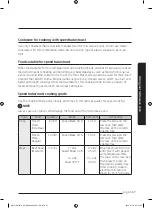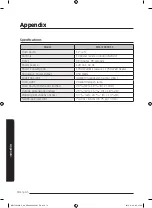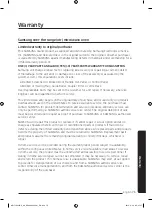
62
English
Cooking guide
C
ooking g
uide
Recommended cooking utensils
• Dense foods, such as potatoes, take longer to
heat than lighter foods. Food with a delicate
texture should be heated at a low power
level to prevent it from becoming tough.
• Altitude and the type of cookware you are
using can affect cooking time. When trying
a new recipe, use the minimum cooking
time and check the food occasionally to
prevent overcooking.
• Food with a non-porous skin such as
potatoes or hot dogs should be pierced to
prevent bursting.
• Frying with oil or fat is not recommended.
Fat and oil can suddenly boil over and
cause severe burns.
• Some ingredients heat faster than others.
For example, the jelly inside a jelly
doughnut will be hotter than the dough.
Keep this in mind to avoid burns.
• Home canning in the microwave oven is
not recommended because all harmful
bacteria may not be destroyed by the
microwave heating process.
• Although microwaves do not heat the
cookware, the heat from the food is often
transferred to the cookware. Always use
pot holders when removing food from the
microwave and instruct children to do the
same.
• Making candy in the microwave is not
recommended as candy can heat to very
high temperatures. Keep this in mind to
avoid injury.
Guide for cooking eggs in your
microwave
• Never cook eggs in the shell and never
warm hard-cooked eggs in the shell. They
can explode.
• Always pierce whole eggs to keep them
from bursting.
• Cook eggs just until set. They become
tough if overcooked.
Guide for cooking vegetables in
your microwave
• Vegetables should be washed just before
cooking. Often, no extra water is needed.
If you are cooking dense vegetables such
as cubed potatoes, carrots, or green beans,
add about ¼ cup water.
• Small vegetables (sliced carrots, peas, lima
beans, etc.) will cook faster than larger ones.
• Whole vegetables, such as potatoes, acorn
squash, or corn on the cob, should be
arranged in a circle on the turntable before
cooking. They will cook more evenly if
turned over after half the cooking time.
• Always place vegetables like asparagus
and broccoli with the stem ends pointing
towards the edge of the dish and the tips
toward the center.
• When cooking cut vegetables, always
cover the dish with a lid or vented
microwavable plastic wrap.
• Whole, unpeeled vegetables such as
potatoes, squash, eggplant, etc., should have
their skin pricked in several spots before
cooking to prevent them from bursting.
• For more even cooking, stir or rearrange
whole vegetables halfway through the
cooking time.
• Generally, the denser the food, the longer
the standing time. (Standing time refers to
the time necessary for dense, large foods
and vegetables to finish cooking after they
come out of the oven.) A baked potato
can stand on the counter for five minutes
before cooking is completed, while a dish
of peas can be served immediately.
MC17J8000CS_AA _DE68-04224C-01_EN.indd 62
2015-11-26 �� 4:07:03
Содержание MC17J8000CS
Страница 2: ...Microwave Oven User manual MC17J8000CS MC17J8000CS_AA _DE68 04224C 01_EN indd 1 2015 11 26 4 06 47 ...
Страница 78: ...Memo MC17J8000CS_AA _DE68 04224C 01_EN indd 77 2015 11 26 4 07 07 ...
Страница 79: ...Memo MC17J8000CS_AA _DE68 04224C 01_EN indd 78 2015 11 26 4 07 07 ...
Страница 80: ...Memo MC17J8000CS_AA _DE68 04224C 01_EN indd 79 2015 11 26 4 07 07 ...
















































